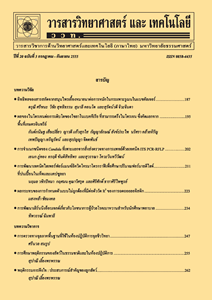ประสิทธิภาพการสีของพันธุ์ข้าวหอมธรรมศาสตร์
Main Article Content
Abstract
บทคัดย่อ
การทดสอบหาประสิทธิภาพการสีของพันธุ์ข้าวหอมธรรมศาสตร์โดยการเปรียบเทียบกับพันธุ์ขาวดอกมะลิ 105 มีวัตถุประสงค์เพื่อการวิเคราะห์ว่าจะสามารถผลิตข้าวสารขาว 100 % จากพันธุ์ข้าวหอมธรรมศาสตร์ได้หรือไม่ โดยถ้าผลจากการสีได้ต้นข้าว (head rice) (ข้าวสารเต็มเมล็ดรวมกับข้าวสารหักไม่เกิน 2/10 ของเมล็ดเต็ม) ตั้งแต่ 40 % โดยน้ำหนักของข้าวเปลือกก็แสดงว่าพันธุ์ข้าวนี้สามารถผลิตเป็นข้าวสารขาว 100 % ได้ โดยในการวิเคราะห์มีการชั่งน้ำหนักข้าวเปลือก น้ำหนักข้าวกล้อง น้ำหนักข้าวสารรวม และน้ำหนักต้นข้าวที่ระดับความชื้นของเมล็ด 14 % เพื่อนำไปวิเคราะห์หาเปอร์เซ็นต์แกลบ เปอร์เซ็นต์รำ เปอร์เซ็นต์ข้าวสารรวม และเปอร์เซ็นต์ข้าวหัก จากผลการวิเคราะห์พบว่าพันธุ์ข้าวหอมธรรมศาสตร์และพันธุ์ข้าวขาวดอกมะลิ 105 มีเปอร์เซ็นต์ของต้นข้าวไม่แตกต่างกันอย่างมีนัยสำคัญทางสถิติ เป็น 51.12 และ 50.97 % ของน้ำหนักข้าวเปลือก ตามลำดับ หรือคิดเป็น 75.01 และ 75.12 ของน้ำหนักข้าวสารรวม ตามลำดับ ซึ่งแสดงให้เห็นว่าสามารถที่จะผลิตข้าวสารขาว 100 % จากข้าวเปลือกของทั้ง 2 พันธุ์ นี้ได้ โดยเฉพาะอย่างยิ่งถ้ามีการเพิ่มการผลิตพันธุ์ข้าวหอมธรรมศาสตร์มากกว่า 1 ครั้งต่อปี และนำข้าวเปลือกที่ได้ไปผลิตเป็นข้าวสารขาว 100 % ก็จะเป็นการช่วยยกระดับรายได้ของเกษตรกรผู้ปลูกข้าวและรายได้รวมของประเทศให้สูงขึ้นไปได้อย่างเด่นชัดอีกด้วย
คำสำคัญ : ประสิทธิภาพการสี; พันธุ์ข้าวหอมธรรมศาสตร์; ข้าวสารขาว 100 %; ต้นข้าว; ข้าวหัก
Abstract
Milling efficiencies of Thammasat Aromatic Rice Variety (TARV) and Khao Dawk Mali 105 (KDML 105) were analytically tested to determine if TARV paddy can be produced into 100 % white milled rice. It has been proved that if the head rice (full kernel including broken kernel with at least 2/10 full kernel left) is gained up to at least 40 % (by weight) of paddy, it will be able to produce 100 % white milled rice. The analysis was done by weighing paddy, brown rice, total milled rice, whole kernels and broken kernels and then the percentage of head rice was calculated from the total weight of paddy. The result showed that both TARV and KDML 105 gave no significant difference in the percentage of head rice (51.12 and 50.97 %) meaning that paddy from both rice varieties can be produced into 100 % white milled rice. Hopefully, the farmers’ income must be increased due to the fact that TARV has the same good cooking and eating qualities of KDML 105 but TARV can be grown more than once a year since it is a photo insensitive variety.
Keywords: milling efficiency; Thammasat Aromatic Rice Variety; 100 % white milled rice; head rice; broken kernel


